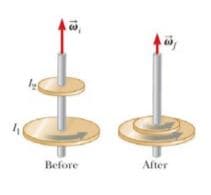A disk with a moment of inertia I1 rotates about a frictionless, vertical axle with angular speed ωi. A second disk, this one having a moment of inertia I2 and initially not rotating, drops onto the first disk (see figure). Because of friction between the surfaces, the two eventually reach the same angular speed ωf. (a) Calculate ωf. (b) Calculate the ratio of the final to the initial rotational energy.
A disk with a moment of inertia I1 rotates about a frictionless, vertical axle with angular speed ωi. A second disk, this one having a moment of inertia I2 and initially not rotating, drops onto the first disk (see figure). Because of friction between the surfaces, the two eventually reach the same angular speed ωf. (a) Calculate ωf. (b) Calculate the ratio of the final to the initial rotational energy.
Related questions
Question
A disk with a moment of inertia I1 rotates about a frictionless, vertical axle with angular speed ωi. A second disk, this one having a moment of inertia I2 and initially not rotating, drops onto the first disk (see figure). Because of friction between the surfaces, the two eventually reach the same angular speed ωf.
(a) Calculate ωf.
(b) Calculate the ratio of the final to the initial rotational energy.

Transcribed Image Text:Before
After
Expert Solution
This question has been solved!
Explore an expertly crafted, step-by-step solution for a thorough understanding of key concepts.
This is a popular solution!
Trending now
This is a popular solution!
Step by step
Solved in 3 steps
